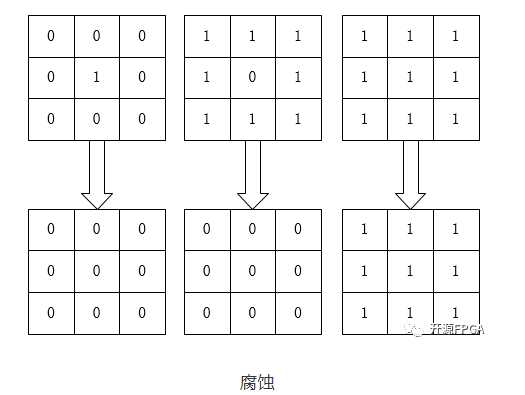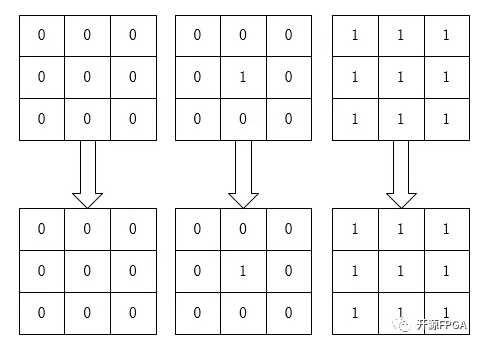腐蚀膨胀-算法
2021-01-24 22:14
标签:des pre 代码 算法 salt ble 过程 inf p12 本篇文章要分享的是基于MATLAB的腐蚀膨胀算法实现,腐蚀膨胀是形态学图像处理的基础,腐蚀在二值图像的基础上做“收缩”或“细化”操作,膨胀在二值图像的基础上做“加长”或“变粗”的操作。 什么是二值图像呢?把一幅图片看做成一个二维的数组,那么二值图像是一个只有0和1的逻辑数组,我们前面Sobel边缘检测后的图像输出边缘效果,设置个阈值,大于阈值输出为1,小于阈值输出为0,最后输出就是一幅二值图像了。 腐蚀是一种消除边界点,使边界向内部收缩的过程。可以用来消除小且无意义的物体。用3X3的结构元素,扫描图像的每一个像素,用结构元素与其覆盖的二值图像做“与”操作,如果都为1,结果图像的该像素为1。否则为0。结果会使二值图像小一圈。 有一个形象的比喻来可以说明该运算,用0表示蛀虫,1表示大米。蛀虫腐蚀大米的过程便是 腐蚀 如图所示,对于一个像素矩阵而言,只要有蛀虫(0)的存在,大米(1)就会被腐蚀掉了,即使只存在一个蛀虫(0),但是还是会被蛀虫腐蚀完毕,最后一幅图上面由于没有蛀虫(0)所以大米完好无损。 关于算法的实现,可以用下式子来表示,即3x3像素的运算: P = P11 & P12 & P13 & P21 & P22 & P23 & P31 & P32 & P33 在FPGA中,为了通过面积去换速度,我们将上式改变如下: P1 = P11 & P12 & P13 P2 = P21 & P22 & P23 P3 = P31 & P32 & P33 P = P1 & P2 & P3 MATLAB中可以直接写一个按位或运算。 膨胀是将与物体接触的所有背景点合并到该物体中,使边界向外部扩张的过程。可以用来填补物体中的空洞。用3X3的结构元素,扫描图像的每一个像素,用结构元素与其覆盖的二值图像做“与”操作,如果都为0,结果图像的该像素为0,。否则为1。结果使二值图像扩大一圈。 先腐蚀后膨胀的过程称为开运算。用来消除小物体、在纤细点处分离物体、平滑较大物体的边界的同时并不明显的改变其面积。先膨胀后腐蚀的过程称为比运算,用来填充物体内细小空间、连接邻近物体、平滑其边界的同时并不明显改变其面积。 膨胀算法用最简单的比喻来描述:0表示害虫,1表示青蛙,青蛙吃了害虫表示膨胀运算,我们用3*3像素阵列来解释: 膨胀 如图所示,图左只有害虫(0),所以害虫都活着,中间那个图,虽然只有一个害虫,但是还是会被青蛙全部吃掉,最右边的那幅图,都是青蛙,所以青蛙始终是青蛙。 关于算法的实现,可以用下式子来表示,即3x3像素的运算: P = P11 | P12 | P13 | P21 | P22 | P23 | P31 | P32 | P33 在HDL中,为了通过面积去换速度,我们将上式改变如下: P1 = P11 | P12 | P13 P2 = P21 | P22 | P23 P3 = P31 | P32 | P33 P = P1 | P2 | P3 MATLAB中可以直接写一个按位与运算。 先腐蚀后膨胀叫开运算,开运算的作用是清除图像边缘周围非边缘的细小的点。先膨胀后腐蚀为闭运算,闭运算的作用是清除图像内部的空洞, 如果我们的目标物体外面有很多无关的小区域,就用开运算去除掉;如果物体内部有很多小黑洞,就用闭运算填充掉。 bitand(), 对十进制数进行逐位逻辑与运算:先将十进制数转换成二进制数,然后逐位与运算,其运算结果转换为十进制。 bitor(), 对十进制数进行逐位逻辑或运算:先将十进制数转换成二进制数,然后逐位与运算,其运算结果转换为十进制。 腐蚀膨胀-算法 标签:des pre 代码 算法 salt ble 过程 inf p12 原文地址:https://www.cnblogs.com/wanglinwensi/p/12863954.html腐蚀

膨胀

开运算闭运算
MATLAB逻辑运算函数
MATLAB代码实现
%%%imopen Erosion_Dilation
clc,clear,close all,clear all
img = imread(‘1.png‘);
img_gray = rgb2gray(img);
figure;
subplot(2,2,1),imshow(img),title(‘灰度图像‘)
subplot(2,2,2),imshow(img_gray),title(‘灰度图像‘)
hold on;
%%中值滤波
%Median Filter
imgn = imnoise(img_gray,‘salt & pepper‘,0.02);
subplot(2,2,3),imshow(imgn),title(‘椒盐噪声图像‘);
Median_Img = img_gray;
[ROW,COL] = size(Median_Img);
for r = 2:ROW-1
for c = 2:COL-1
median3x3 =[imgn(r-1,c-1) imgn(r-1,c) imgn(r-1,c+1)
imgn(r,c-1) imgn(r,c) imgn(r,c+1)
imgn(r+1,c-1) imgn(r+1,c) imgn(r+1,c+1)];
sort1 = sort(median3x3, 2, ‘descend‘);
sort2 = sort([sort1(1), sort1(4), sort1(7)], ‘descend‘);
sort3 = sort([sort1(2), sort1(5), sort1(8)], ‘descend‘);
sort4 = sort([sort1(3), sort1(6), sort1(9)], ‘descend‘);
mid_num = sort([sort2(3), sort3(2), sort4(1)], ‘descend‘);
Median_Img(r,c) = mid_num(2);
end
end
subplot(2,2,4),imshow(Median_Img),title(‘中值滤波图像‘)
%%Sobel算子边缘检测
Median_Img = double(Median_Img);
Sobel_Img = zeros(ROW,COL);
Sobel_Threshold = 80;
for r = 2:ROW-1
for c = 2:COL-1
Sobel_x = Median_Img(r-1,c+1) + 2*Median_Img(r,c+1) + Median_Img(r+1,c+1) - Median_Img(r-1,c-1) - 2*Median_Img(r,c-1) - Median_Img(r+1,c-1);
Sobel_y = Median_Img(r-1,c-1) + 2*Median_Img(r-1,c) + Median_Img(r-1,c+1) - Median_Img(r+1,c-1) - 2*Median_Img(r+1,c) - Median_Img(r+1,c+1);
%Sobel_Num = abs(Sobel_x) + abs(Sobel_y);
Sobel_Num = sqrt(Sobel_x^2 + Sobel_y^2);
if(Sobel_Num > Sobel_Threshold)
Sobel_Img(r,c)=1;
else
Sobel_Img(r,c)=0;
end
end
end
figure
subplot(2,2,1),imshow(Sobel_Img),title(‘Sobel算子图像‘)
BW1=edge(img_gray,‘sobel‘); %用Sobel算子进行边缘检测
subplot(2,2,2),imshow(BW1),title(‘Sobel算子图像‘)
%%腐蚀算法
Erosion_img = zeros(ROW,COL);
for r = 2:ROW-1
for c = 2:COL-1
%and1 = bitand(Sobel_Img(r-1,c-1) + bitand(Sobel_Img(r-1,c) + Sobel_Img(r-1,c+1)));
%and2 = bitand(Sobel_Img(r ,c-1) + bitand(Sobel_Img(r ,c) + Sobel_Img(r ,c+1)));
%and3 = bitand(Sobel_Img(r+1,c-1) + bitand(Sobel_Img(r+1,c) + Sobel_Img(r+1,c+1)));
%Erosion_img(r,c) = bitand(and1,bitand(and2,and3));
and1 = Sobel_Img(r-1,c-1) & Sobel_Img(r-1,c) & Sobel_Img(r-1,c+1);
and2 = Sobel_Img(r ,c-1) & Sobel_Img(r ,c) & Sobel_Img(r ,c+1);
and3 = Sobel_Img(r+1,c-1) & Sobel_Img(r+1,c) & Sobel_Img(r+1,c+1);
Erosion_img(r,c) = and1 & and2 & and3;
end
end
subplot(2,2,3),imshow(Erosion_img),title(‘腐蚀图像‘)
%%膨胀算法
Dilation_img = zeros(ROW,COL);
for r = 2:ROW-1
for c = 2:COL-1
%and1 = bitand(Sobel_Img(r-1,c-1) + bitand(Sobel_Img(r-1,c) + Sobel_Img(r-1,c+1)));
%and2 = bitand(Sobel_Img(r ,c-1) + bitand(Sobel_Img(r ,c) + Sobel_Img(r ,c+1)));
%and3 = bitand(Sobel_Img(r+1,c-1) + bitand(Sobel_Img(r+1,c) + Sobel_Img(r+1,c+1)));
%Erosion_img(r,c) = bitand(and1,bitand(and2,and3));
and1 = Sobel_Img(r-1,c-1) | Sobel_Img(r-1,c) | Sobel_Img(r-1,c+1);
and2 = Sobel_Img(r ,c-1) | Sobel_Img(r ,c) | Sobel_Img(r ,c+1);
and3 = Sobel_Img(r+1,c-1) | Sobel_Img(r+1,c) | Sobel_Img(r+1,c+1);
Dilation_img(r,c) = and1 | and2 | and3;
end
end
subplot(2,2,4),imshow(Dilation_img),title(‘膨胀图像‘)
%%开运算-先腐蚀后膨胀算法
Erosion_Dilation_img = zeros(ROW,COL);
for r = 2:ROW-1
for c = 2:COL-1
%and1 = bitand(Sobel_Img(r-1,c-1) + bitand(Sobel_Img(r-1,c) + Sobel_Img(r-1,c+1)));
%and2 = bitand(Sobel_Img(r ,c-1) + bitand(Sobel_Img(r ,c) + Sobel_Img(r ,c+1)));
%and3 = bitand(Sobel_Img(r+1,c-1) + bitand(Sobel_Img(r+1,c) + Sobel_Img(r+1,c+1)));
%Erosion_img(r,c) = bitand(and1,bitand(and2,and3));
and1 = Erosion_img(r-1,c-1) | Erosion_img(r-1,c) | Erosion_img(r-1,c+1);
and2 = Erosion_img(r ,c-1) | Erosion_img(r ,c) | Erosion_img(r ,c+1);
and3 = Erosion_img(r+1,c-1) | Erosion_img(r+1,c) | Erosion_img(r+1,c+1);
Erosion_Dilation_img(r,c) = and1 | and2 | and3;
end
end
figure
subplot(1,2,1),imshow(Erosion_Dilation_img),title(‘先腐蚀在膨胀图像‘)
%%闭运算-先膨胀后腐蚀算法
Dilation_Erosion_img = zeros(ROW,COL);
for r = 2:ROW-1
for c = 2:COL-1
%and1 = bitand(Sobel_Img(r-1,c-1) + bitand(Sobel_Img(r-1,c) + Sobel_Img(r-1,c+1)));
%and2 = bitand(Sobel_Img(r ,c-1) + bitand(Sobel_Img(r ,c) + Sobel_Img(r ,c+1)));
%and3 = bitand(Sobel_Img(r+1,c-1) + bitand(Sobel_Img(r+1,c) + Sobel_Img(r+1,c+1)));
%Erosion_img(r,c) = bitand(and1,bitand(and2,and3));
and1 = Dilation_img(r-1,c-1) & Dilation_img(r-1,c) & Dilation_img(r-1,c+1);
and2 = Dilation_img(r ,c-1) & Dilation_img(r ,c) & Dilation_img(r ,c+1);
and3 = Dilation_img(r+1,c-1) & Dilation_img(r+1,c) & Dilation_img(r+1,c+1);
Dilation_Erosion_img(r,c) = and1 & and2 & and3;
end
end
subplot(1,2,2),imshow(Dilation_Erosion_img),title(‘先膨胀在腐蚀图像‘)